UHPC Viability for Nuclear Storage Facilities: Synthesis and Critical Review of Durability, Thermal, and Nuclear Properties for Informed Mix Modifications
Abstract
1. Introduction
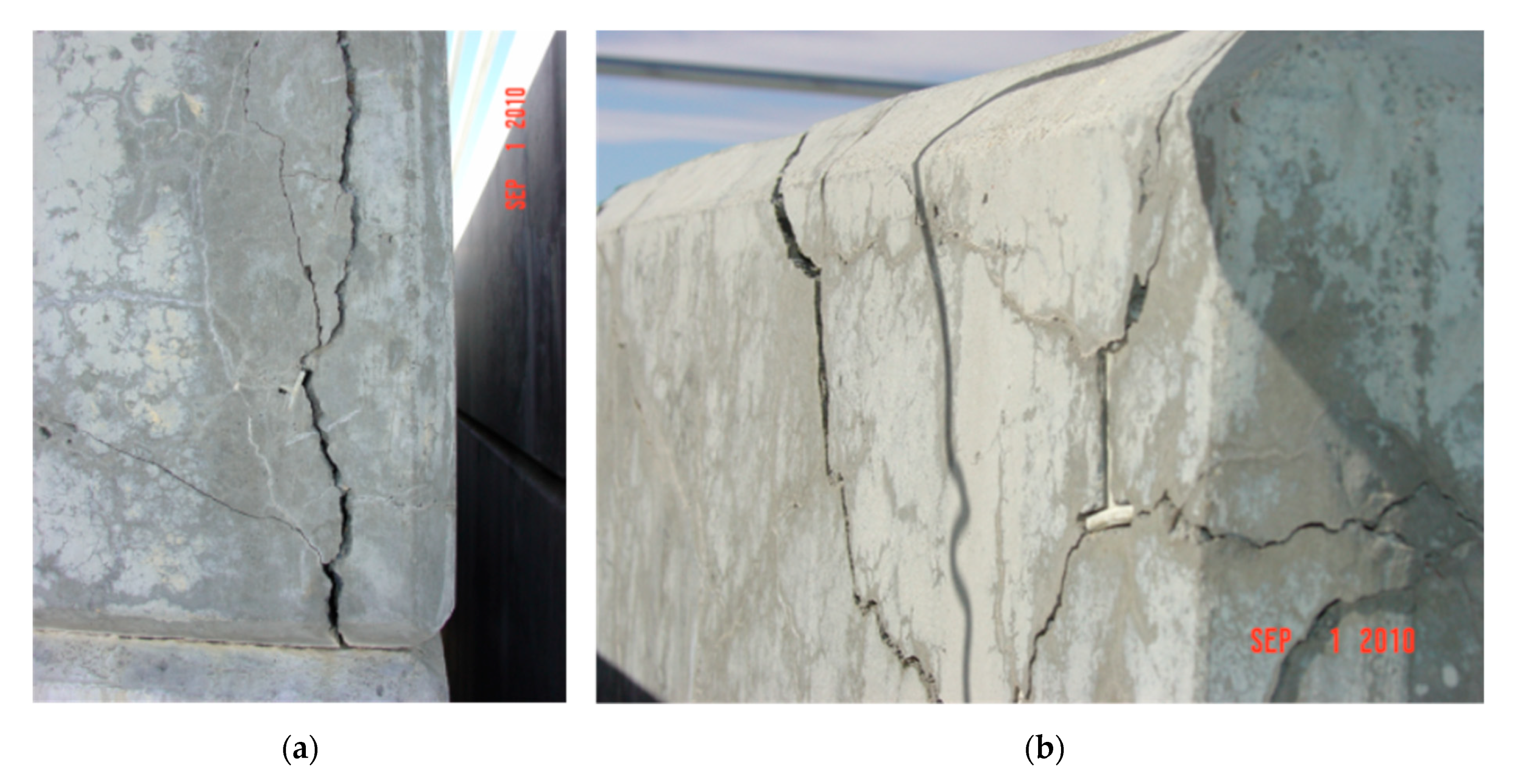
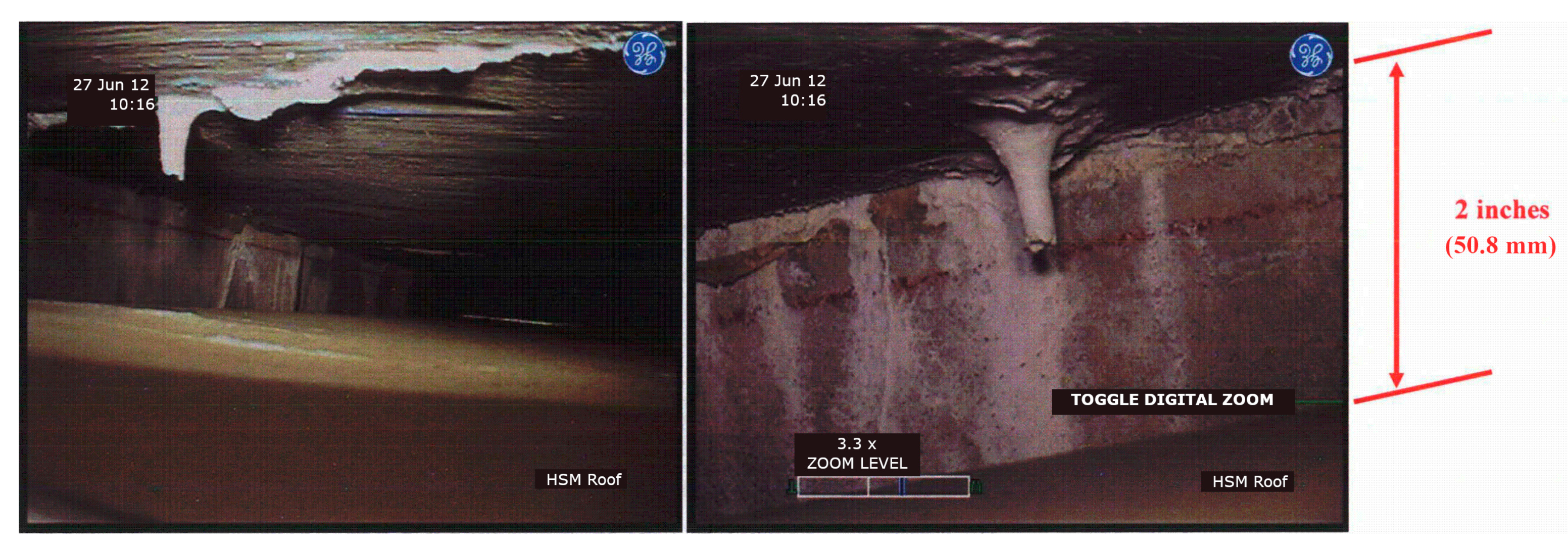
| Example Composition | NSC | UHPC |
|---|---|---|
| Component: amount, kg/m3 | Cement: 370 – Water: 204 10 mm coarse aggregate: 369 20 mm coarse aggregate: 738 Sand: 679 – – | Cement: 1050 Silica fume: 268 Water: 180 – – Sand: 514 Steel fibers: 858 Superplasticizer: 44 |
| Water/cement ratio | 0.55 | 0.20 |
| Water/binder ratio | – | 0.16 |
| Properties | NSC | UHPC |
|---|---|---|
| Compressive strength, MPa | <55 | 124–207 |
| Flexural strength, MPa | <4.6 | 17–41 |
| Shear strength, MPa | <1.2 | >4.1 |
| Direct tension, MPa | <3 | Up to 10 |
| Modulus of elasticity, GPA | 20–40 | 40–55 |
| Ultimate compressive strain | 0.003 | 0.015–0.03 |
2. DCSS Non-Nuclear Degradation Mechanisms and Comparative Performance of UHPC and Conventional Concrete
2.1. Freeze–Thaw Damage
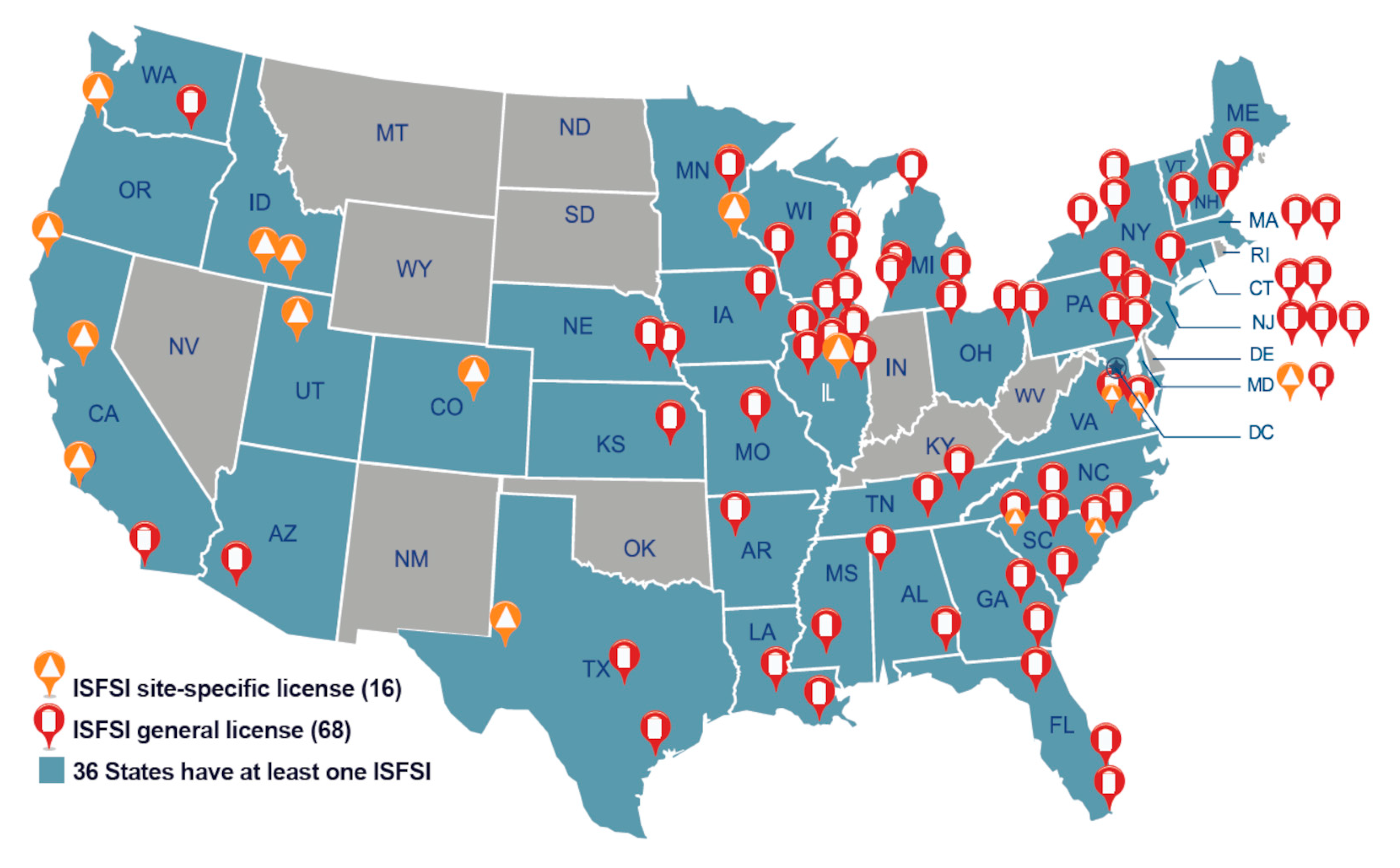
2.2. Chloride Ingress
2.3. Salt Scaling
2.4. Sulfate Attack
2.5. Alkali–Silica Reaction
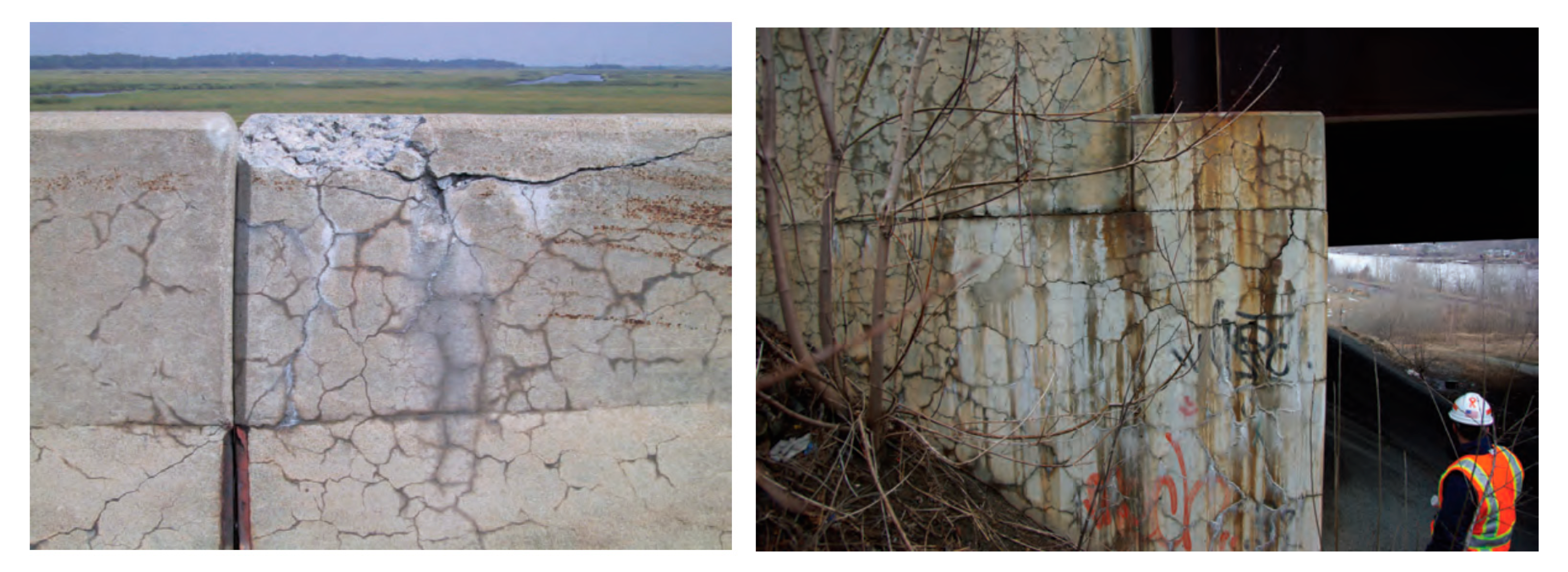
2.6. Carbonation
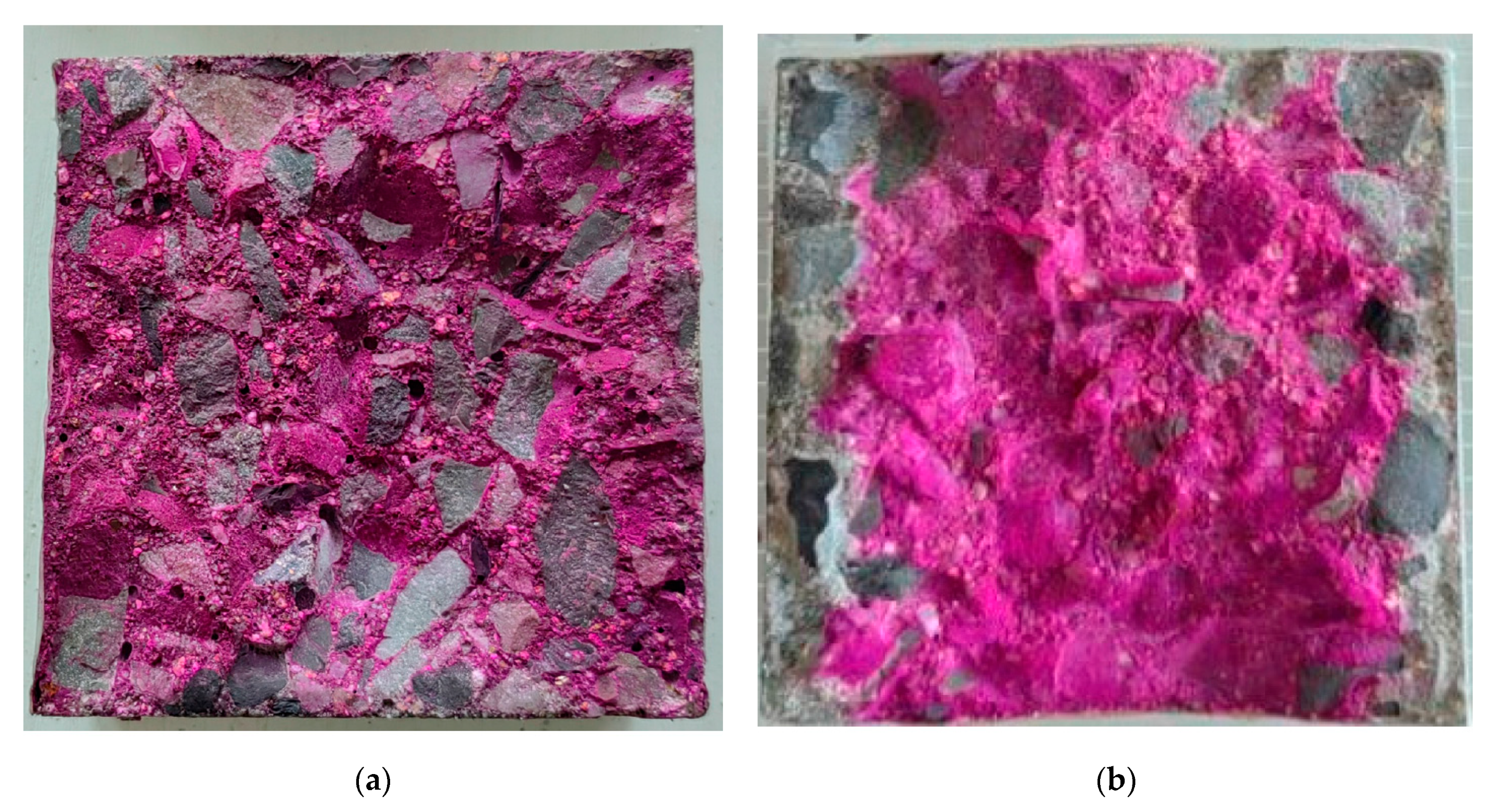
2.7. Summary of Comparative Relevant NSC and UHPC Durability Properties
| Durability Characteristic | Type of Concrete | Remarks | |
|---|---|---|---|
| NSC | UHPC | ||
| Relative dynamic modulus, % | 39 | 90 | 1000 freeze-thaw cycles, ASTM C666/C666M |
| Chloride ion penetration depth, mm | 23 | 1 | 6 h accelerated migration test |
| Chloride diffusion coefficient, m2/s | 1.32 × 10−11 | 1.42 × 10−14 | 95 days of exposure, ASTM C1556 |
| Salt scaling mass, g/m2 | >1000 | <10 | 56 freeze-thaw cycles, ASTM C672/C672M |
Sulfate attack: reduction, %, in
| 52.29 55.42 62.12 32.80 | 10.66 16.96 20.29 19.37 | 180 days of exposure, MgSO4 solution of 10,000 ppm |
| Alkali–silica reaction expansion, % | 0.28 | 0.012 | 28 days of exposure, ASTM C1260 |
| Carbonation depth, mm | 12 | 0 | 6 months, environmental chamber with 50% CO2 |
3. Thermal and Radiation-Induced Degradation Mechanisms and Comparative UHPC and NSC Performance in DSCC Nuclear Settings
3.1. Effects of Exposure to High Temperature
3.2. Effects of Radiation on Concrete
3.2.1. Neutron Radiation
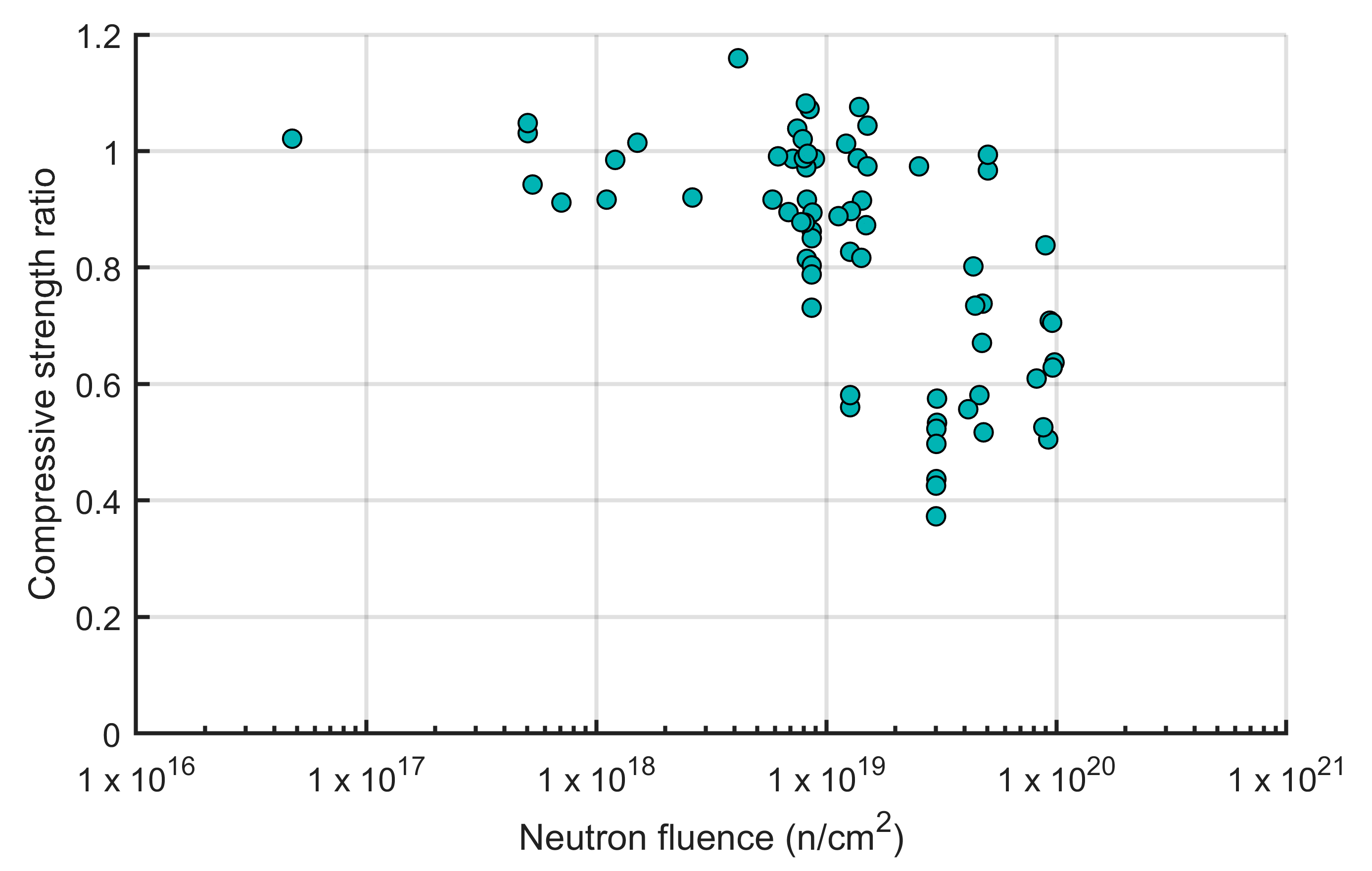
3.2.2. Gamma Radiation
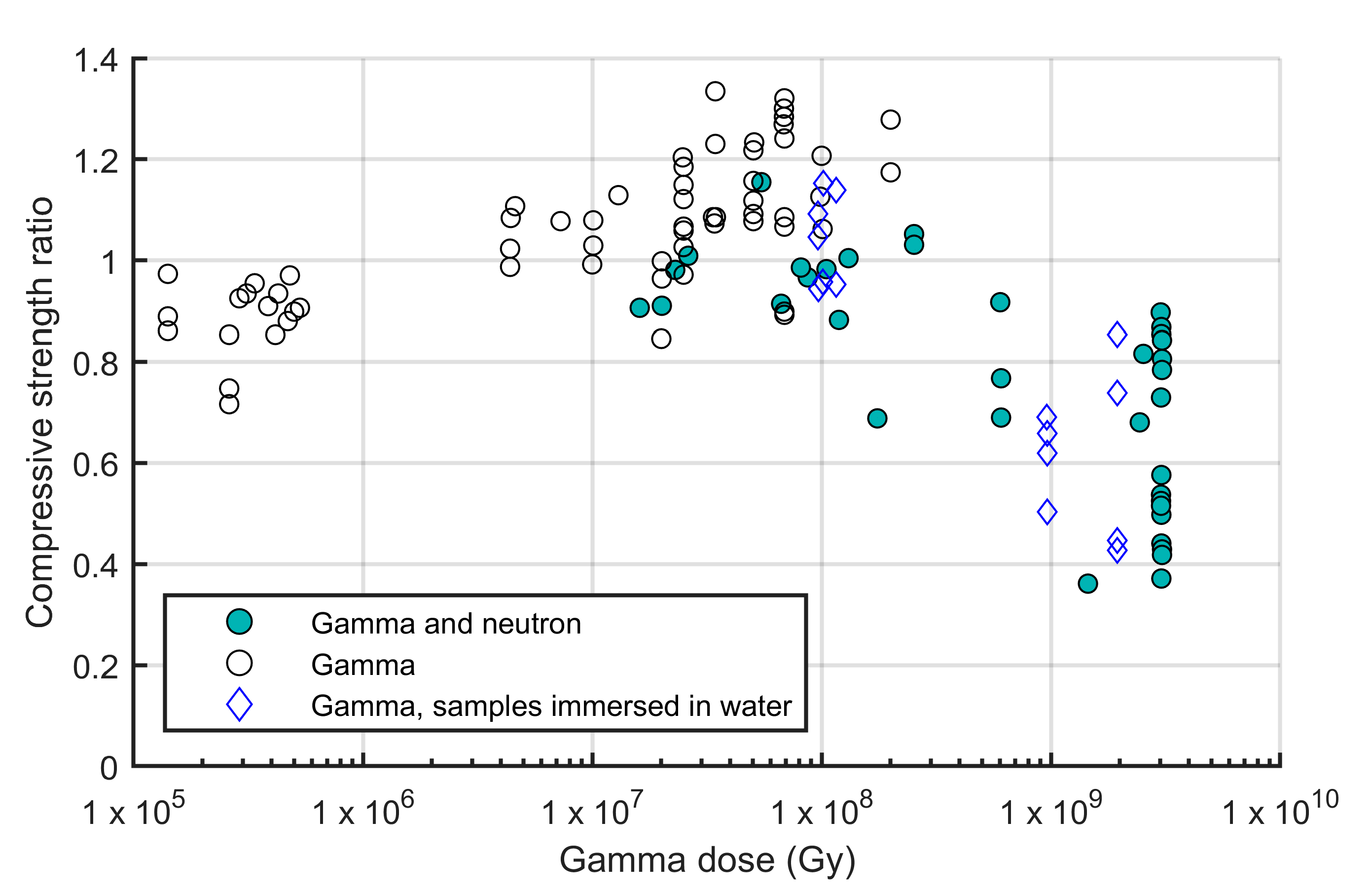
3.2.3. Knowledge Gaps for UHPC Radiation Behavior
4. Radiation Attenuation of UHPC
4.1. Gamma-Ray Attenuation
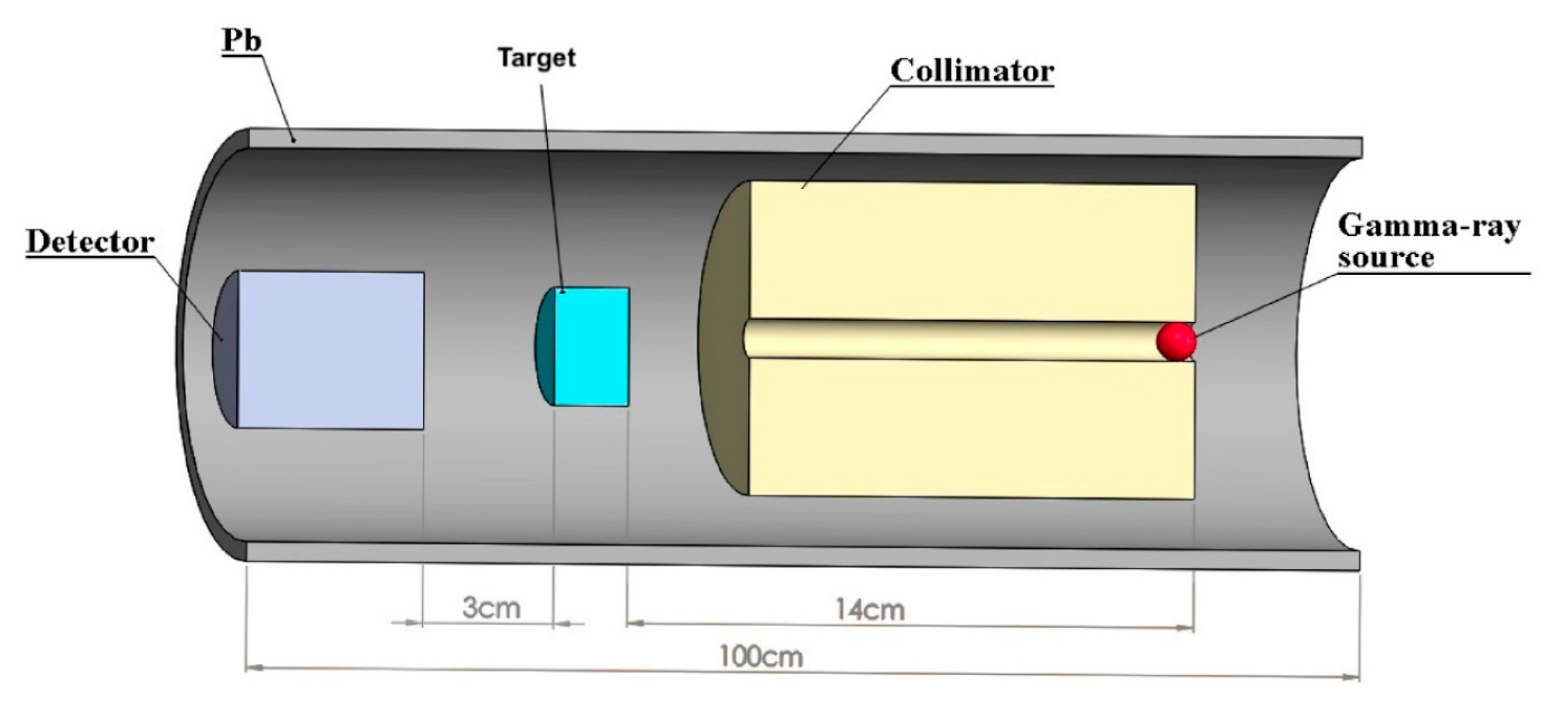
| Study | Linear Attenuation Coefficient (cm−1) | ||
|---|---|---|---|
| Experiments | Gamma-ray source | ||
| 137Cs | 60Co | ||
| Azreen et al. [116] | 0.155 | 0.096 | |
| Tufekci and Gokce [117]: Reported for different water/binder ratios of 0.18, 0.24, and 0.36 | 0.173 | 0.116 | |
| 0.177 | 0.117 | ||
| 0.169 | 0.111 | ||
| Rashid et al. [118] | 0.146 | 0.091 | |
| Khan et al. [119] | 0.187 | − | |
| Han et al. [120] | 0.154 | − | |
| Theoretical calculations | Decay energy (MeV) | ||
| 0.662 | 1.173 | 1.332 | |
| Gökçe et al. [121] | ≈0.202 | ≈0.152 | ≈0.144 |
4.2. Neutron Attenuation
5. Possible Mix Modifications of UHPC
5.1. Enhancement in Gamma-Ray Attenuation
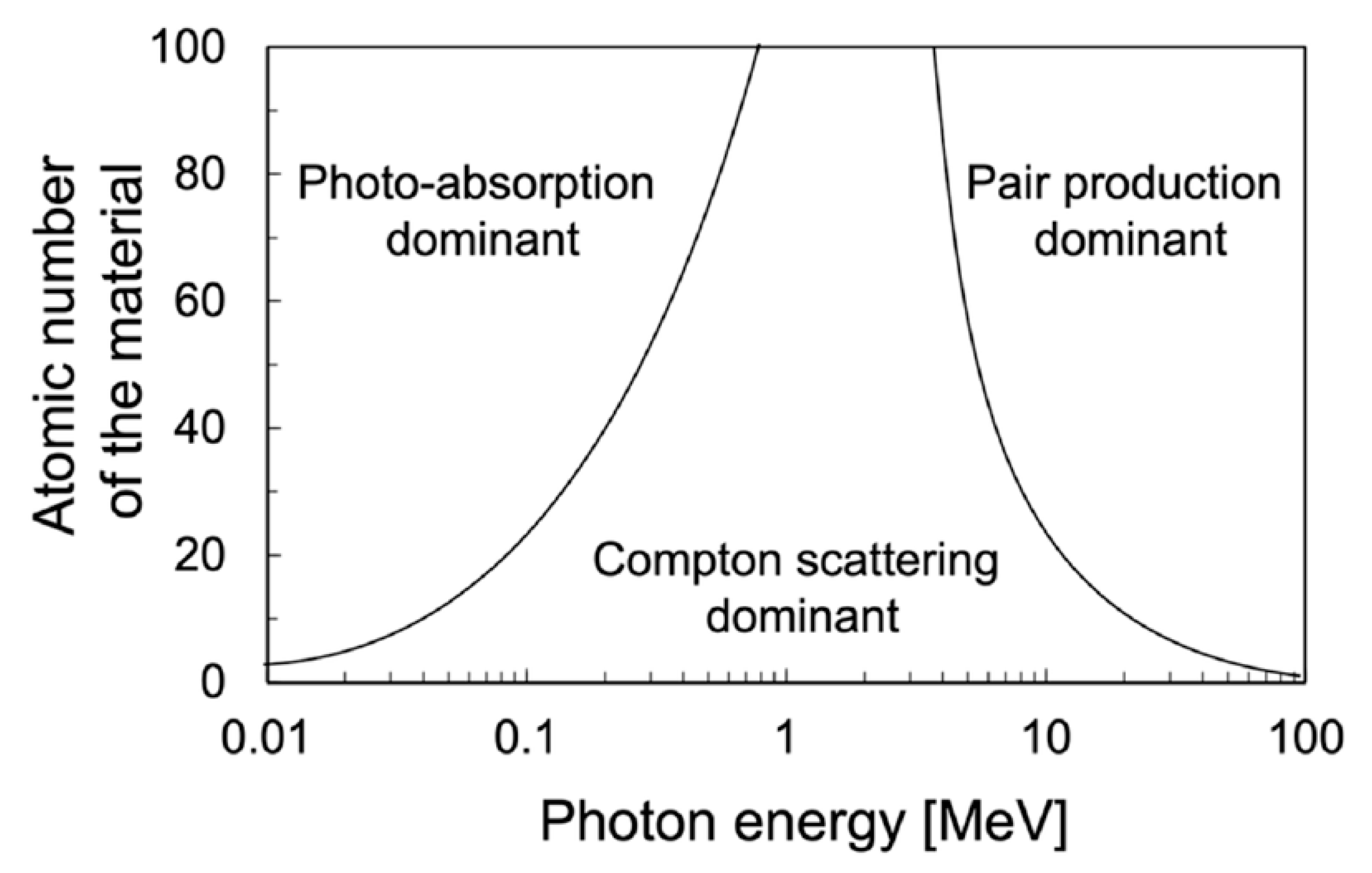

5.2. Enhancement in Neutron Attenuation
6. Concluding Remarks
- UHPC has better long-term performance parameters and durability characteristics in response to the identified degradation mechanisms in nuclear settings than conventional concrete.
- Specific desired attributes such as drying shrinkage that results from thermal desiccation is minimized for UHPC.
- For gamma radiation, hematite and granulated ferrous waste are promising additives to be considered for the future mix design of UHPC.
- Two major knowledge gaps are identified herein and urgently recommended for future research to consider as follows: (1) understanding the radiation-induced degradation mechanisms of UHPC and allowable limits of neutron fluences and gamma doses, which can affect its mechanical properties; and (2) evaluating the neutron attenuation performance of UHPC along with the effects of the possible mix modifications on improving this aspect of behavior.
Author Contributions
Funding
Conflicts of Interest
List of Abbreviations
| ACI | American Concrete Institute |
| ASTM | American Society for Testing and Materials |
| ASR | Alkali–silica reaction |
| DCSS | Dry cask storage system |
| ISFSI | Independent spent fuel storage installation |
| NPP | Nuclear power plant |
| NRC | Nuclear Regulatory Commission |
| NSC | Normal strength concrete |
| NUREG | Nuclear Regulatory Report Series |
| SNF | Spent nuclear fuel |
| RCPT | Rapid chloride permeability test |
| UHPS | Ultra-high-performance concrete |
References
- U.S. GAO. Spent Nuclear Fuel—Accumulating Quantities at Commercial Reactors Present Storage and Other Challenges; Report to Congressional Requesters, GAO-12-797; United States Government Accountability Office: Washington, DC, USA, 2012.
- U.S. NRC. Spent Fuel Pools. Available online: https://www.nrc.gov/waste/spent-fuel-storage/pools.html (accessed on 28 November 2024).
- Code of Federal Regulations. Title 10, Energy, Part 72—Licensing Requirements for the Independent Storage of Spent Nuclear Fuel, High-Level Radioactive Waste, and Reactor-related Greater than Class C Waste; 10 CFR Part 72; Office of the Federal Register National Archives and Records Administration: Washington, DC, USA, 2014; pp. 384–449.
- U.S. NRC. NRC Maps of Independent Spent Fuel Storage Installations (ISFSI). Available online: https://www.nrc.gov/reading-rm/doc-collections/maps/isfsi.html (accessed on 28 November 2024).
- U.S. NRC. Standard Review Plan for Spent Fuel Dry Storage Systems and Facilities; NUREG-2215 Final Report; United States Nuclear Regulatory Commission: Washington, DC, USA, 2020.
- Raddatz, M.G.; Waters, M.D. Information Handbook on Independent Spent Fuel Storage Installations; NUREG-1571; United States Nuclear Regulatory Commission: Washington, DC, USA, 1996. [Google Scholar]
- U.S. NRC. Dry Spent Fuel Storage Designs: NRC Approved for General Use. Available online: https://www.nrc.gov/waste/spent-fuel-storage/designs.html (accessed on 28 November 2024).
- National Research Council of the National Academies. Safety and Security of Commercial Spent Nuclear Fuel Storage; Public Report; The National Academic Press: Washington, DC, USA, 2006. [Google Scholar]
- APS. Consolidated Interim Storage of Commercial Spent Nuclear Fuel—A Technical and Programmatic Assessment; Nuclear Energy Study Group of the American Physical Society: College Park, MD, USA, 2007. [Google Scholar]
- Macfarlane, A. Interim Storage of Spent Fuel in the United States. Annu. Rev. Energy Environ. 2001, 26, 201–235. [Google Scholar] [CrossRef]
- U.S. NRC. Standard Review Plan for Renewal of Specific Licenses and Certificates of Compliance for Dry Storage of Spent Nuclear Fuel; NUREG-1927 Revision 1 Final Report; United States Nuclear Regulatory Commission: Washington, DC, USA, 2016.
- EPRI. Degradation Mechanisms and Inspection Techniques for Concrete Structures in Dry Storage Systems for Spent Nuclear Fuel; Technical Report 3002016083; The Electric Power Research Institute: Palo Alto, CA, USA, 2019. [Google Scholar]
- He, X.; Benke, R.; Pan, Y.-M.; Caseres, L.; Shukla, P.; Chiang, K.; Pabalan, R.; Willden, G.; Vickers, D. Available Methods for Functional Monitoring of Dry Cask Storage Systems; United States Nuclear Regulatory Commission Contract NRC–HQ–12–C–02–0089; United States Nuclear Regulatory Commission: Washington, DC, USA, 2014. [Google Scholar]
- U.S. NRC. Consolidated Interim Storage Facility (CISF). Available online: https://www.nrc.gov/waste/spent-fuel-storage/cis.html (accessed on 28 November 2024).
- Chowdhury, A.H.; Caseres, L.; Pan, Y.-M.; Oberson, G.; Jones, C. Expert Panel Workshop on Concrete Degradation in Spent Nuclear Fuel Dry Cask Storage Systems—Summary Report; U.S. Nuclear Regulatory Commission Contract NRC–HQ–12–C–02–0089; United States Nuclear Regulatory Commission: Washington, DC, USA, 2016. [Google Scholar]
- U.S. NRC. Three Mile Island Unit 2 Independent Spent Fuel Storage Installation; NRC Inspection Report 072-020/2012-001; United States Nuclear Regulatory Commission: Washington, DC, USA, 2012.
- U.S. NRC. Arkansas Nuclear One; NRC Inspection Report 050-00313/05-013; 050-00368/05-013; 072-00013/04-002; United States Nuclear Regulatory Commission: Washington, DC, USA, 2005.
- CCNPP. Calvert Cliffs Independent Spent Fuel Storage Installation Lead and Supplemental Canister Inspection Report; Calvert Cliffs Nuclear Power Plant, LLC: Lusby, MD, USA, 2012. [Google Scholar]
- Birchall, J.D.; Howard, A.J.; Kendall, K. Flexural strength and porosity of cements. Nature 1981, 289, 388–390. [Google Scholar] [CrossRef]
- Bache, H.H. Densified cement ultra-fine particle-based materials. In Proceedings of the 2nd International Conference on Superplasticizers in Concrete, Ottawa, ON, Canada, 10–12 June 1981. [Google Scholar]
- Richard, P.; Cheyrezy, M. Composition of reactive powder concretes. Cem. Concr. Res. 1995, 25, 1501–1511. [Google Scholar] [CrossRef]
- Sohail, M.G.; Kahraman, R.; Nuaimi, N.A.; Gencturk, B.; Alnahhal, W. Durability characteristics of high and ultra-high performance concretes. J. Build. Eng. 2021, 33, 101669. [Google Scholar] [CrossRef]
- Shi, C.; Wu, Z.; Xiao, J.; Wang, D.; Huang, Z.; Fang, Z. A review on ultra high performance concrete: Part I. Raw materials and mixture design. Constr. Build. Mater. 2015, 101, 741–751. [Google Scholar] [CrossRef]
- Wu, C.; Li, J.; Su, Y. Development of Ultra-High Performance Concrete Against Blasts: From Materials to Structures; Woodhead Publishing Series in Civil and Structural Engineering; Woodhead Publishing: Cambridge, UK, 2018. [Google Scholar] [CrossRef]
- Lam, E.S.-S.; Fang, S. Direct Tensile Behavior of Normal-Strength Concrete at Elevated Temperatures. ACI Mater. J. 2014, 111, 641–650. [Google Scholar] [CrossRef]
- Rossi, P.; Arca, A.; Parant, E.; Fakhri, P. Bending and compressive behaviors of a new cement composite. Cem. Concr. Res. 2005, 35, 27–33. [Google Scholar] [CrossRef]
- Karmacharya, A.; Chao, S.-H. Precast Ultra-High-Performance Fiber-Reinforced Concrete (UHP-FRC) for Fast and Sustainable Pavement Repair. MATEC Web Conf. 2019, 271, 01004. [Google Scholar] [CrossRef]
- Nguyen, T.V.; Nguyen, T.A.; Le, A.H. A review on performance of composite structures combining UHPC and normal concrete. Struct. Eng. Mech. 2024, 91, 149–161. [Google Scholar]
- Graybeal, B.A. Structural Behavior of Ultra-High Performance Concrete Prestressed I-Girders; FHWA–HRT–06–115; Federal Highway Administration: McLean, VA, USA, 2006.
- Aaleti, S.; Petersen, B.; Sritharan, S. Design Guide for Precast UHPC Waffle Deck Panel System, Including Connections; FHWA–HIF–13–032; Federal Highway Administration, U.S. Department of Transportation: Washington, DC, USA, 2013.
- Aboukifa, M.; Moustafa, M.A.; Itani, A.M. Comparative Structural Response of UHPC and Normal Strength Concrete Columns under Combined Axial and Lateral Cyclic Loading. ACI Symp. Publ. 2020, 341, 71–96. [Google Scholar] [CrossRef]
- Aboukifa, M.; Moustafa, M.A. Experimental seismic behavior of ultra-high performance concrete columns with high strength steel reinforcement. Eng. Struct. 2021, 232, 111885. [Google Scholar] [CrossRef]
- Elmorsy, M.; Hassan, W.M. Seismic behavior of ultra-high performance concrete elements: State-of-the-art review and test database and trends. J. Build. Eng. 2021, 40, 102572. [Google Scholar] [CrossRef]
- Liu, Y.; Chen, A.; Bai, F.; He, G.; Wang, H.; Wan, J. Experimental and Numerical Investigation of Seismic Performance of UHPC Thin-Walled Short Piers. Adv. Civ. Eng. 2022, 2022, 9384436. [Google Scholar] [CrossRef]
- Russell, H.G.; Graybeal, B.A. Ultra-High Performance Concrete: A State-of-the-Art Report for the Bridge Community; FHWA–HRT–13–060; Federal Highway Administration: McLean, VA, USA, 2013. [Google Scholar]
- Akeed, M.H.; Qaidi, S.; Ahmed, H.U.; Faraj, R.H.; Mohammed, A.S.; Emad, W.; Tayeh, B.A.; Azevedo, A.R.G. Ultra-high-performance fiber-reinforced concrete. Part II: Hydration and microstructure. Case Stud. Constr. Mater. 2022, 17, e01289. [Google Scholar] [CrossRef]
- Akeed, M.H.; Qaidi, S.; Ahmed, H.U.; Faraj, R.H.; Mohammed, A.S.; Emad, W.; Tayeh, B.A.; Azevedo, A.R.G. Ultra-high-performance fiber-reinforced concrete. Part I: Developments, principles, raw materials. Case Stud. Constr. Mater. 2022, 17, e01290. [Google Scholar] [CrossRef]
- Akeed, M.H.; Qaidi, S.; Ahmed, H.U.; Faraj, R.H.; Mohammed, A.S.; Emad, W.; Tayeh, B.A.; Azevedo, A.R.G. Ultra-high-performance fiber-reinforced concrete. Part IV: Durability properties, cost assessment, applications, and challenges. Case Stud. Constr. Mater. 2022, 17, e01271. [Google Scholar] [CrossRef]
- El-Tawil, S.; Tai, Y.-S.; Belcher, J.A., II; Rogers, D. Open-Recipe Ultra-High-Performance Concrete—Busting the cost myth. Concr. Int. 2020, 42, 33–38. [Google Scholar]
- Rasheed, P.A.; Nayar, S.K.; Barsoum, I.; Alfantazi, A. Degradation of Concrete Structures in Nuclear Power Plants: A Review of the Major Causes and Possible Preventive Measures. Energies 2022, 15, 8011. [Google Scholar] [CrossRef]
- ASTM Standard C666/C666M–15; Standard Test Method for Resistance of Concrete to Rapid Freezing and Thawing. ASTM International: West Conshohocken, PA, USA, 2015. [CrossRef]
- Graybeal, B.; Tanesi, J. Durability of an Ultrahigh-Performance Concrete. J. Mater. Civ. Eng. 2007, 19, 848–854. [Google Scholar] [CrossRef]
- Shang, H.-S.; Yi, T.-H. Freeze-Thaw Durability of Air-Entrained Concrete. Sci. World J. 2013, 2013, 650791. [Google Scholar] [CrossRef]
- Lee, M.-G.; Wang, Y.-C.; Chiu, C.-T. A preliminary study of reactive powder concrete as a new repair material. Constr. Build. Mater. 2007, 21, 182–189. [Google Scholar] [CrossRef]
- Hasnat, A.; Ghafoori, N. Freeze-Thaw Resistance of Nonproprietary Ultrahigh-Performance Concrete. J. Cold Reg. Eng. 2021, 35, 04021008. [Google Scholar] [CrossRef]
- Lu, Z.; Feng, Z.-g.; Yao, D.; Li, X.; Ji, H. Freeze-thaw resistance of Ultra-High performance concrete: Dependence on concrete composition. Constr. Build. Mater. 2021, 293, 123523. [Google Scholar] [CrossRef]
- Ahlborn, T.M.; Harris, D.K.; Misson, D.L.; Peuse, E.J. Characterization of Strength and Durability of Ultra-High-Performance Concrete Under Variable Curing Conditions. J. Transp. Res. Board 2011, 2251, 68–75. [Google Scholar] [CrossRef]
- Magureanu, C.; Sosa, I.; Negrutiu, C.; Heghes, B. Mechanical Properties and Durability of Ultra-High-Performance Concrete. ACI Mater. J. 2012, 109, 177–184. [Google Scholar] [CrossRef]
- Angst, U.; Elsener, B.; Larsen, C.K.; Vennesland, Ø. Critical chloride content in reinforced concrete—A review. Cem. Concr. Res. 2009, 39, 1122–1138. [Google Scholar] [CrossRef]
- ACI. Building Code Requirements for Structural Concrete; ACI 318-19; American Concrete Institute: Farmington Hills, MI, USA, 2019. [Google Scholar]
- Stanish, K.D.; Hooton, R.D.; Thomas, M.D.A. Testing the Chloride Penetration Resistance of Concrete: A Literature Review; FHWA Contract DTFH61–97–R–00022; University of Toronto: Toronto, ON, Canada, 1997. [Google Scholar]
- ASTM Standard C1202–22; Standard Test Method for Electrical Indication of Concrete’s Ability to Resist Chloride Ion Penetration. ASTM International: West Conshohocken, PA, USA, 2022. [CrossRef]
- AASHTO. Standard Method of Test for Resistance of Concrete to Chloride Ion Penetration; AASHTO T259-02; American Association of State Highway and Transportation Officials: Washington, DC, USA, 2021. [Google Scholar]
- ASTM Standard C1556-22; Standard Test Method for Determining the Apparent Chloride Diffusion Coefficient of Cementitious Mixtures by Bulk Diffusion. ASTM International: West Conshohocken, PA, USA, 2022. [CrossRef]
- Nordtest. Concrete, Hardened: Accelerated Chloride Penetration; NT BUILD 443; Nordtest: Espoo, Finland, 1995. [Google Scholar]
- Andrade, C. Concepts of the chloride diffusion coefficient. In Proceedings of the Third RILEM Workshop on Testing and Modelling the Chloride Ingress into Concrete, Madrid, Spain, 9–10 September 2002. [Google Scholar]
- Abbas, S.; Soliman, A.M.; Nehdi, M.L. Exploring mechanical and durability properties of ultra-high performance concrete incorporating various steel fiber lengths and dosages. Constr. Build. Mater. 2015, 75, 429–441. [Google Scholar] [CrossRef]
- Bandelt, M.J.; Adams, M.P.; Shirkorshidi, S.M. Comparative Analysis of Rapid Chloride Penetration Testing for Novel Reinforced Concrete Systems; CAIT–UTC–REG57; New Jersey Institute of Technology, University Heights: Newark, NJ, USA, 2022. [Google Scholar]
- Graybeal, B.A. Material Property Characterization of Ultra-High Performance Concrete; FHWA-HRT-06-103; Federal Highway Administration: McLean, VA, USA, 2006. [Google Scholar]
- Schmidt, M.; Fehling, E. Ultra-High-Performance Concrete: Research, Development and Application in Europe. In Proceedings of the 7th International Symposium on Utilization of High Strength/High Performance Concrete, Washington, DC, USA, 20 June–24 June 2005; American Concrete Institute: Farmington Hills, MI, USA, 2005. [Google Scholar] [CrossRef]
- Tanaka, Y.; Maekawa, K.; Kameyama, Y.; Ohtake, A.; Musha, H.; Watanabe, N. The Innovation and Application of UHPFRC Bridges in Japan. In Designing and Building with UHPFRC; Toutlemonde, F., Resplendino, J., Eds.; ISTE Ltd.: London, UK; John Wiley & Sons, Inc.: Hoboken, NJ, USA, 2011; Chapter 12; pp. 149–188. [Google Scholar] [CrossRef]
- Pyo, S.; Tafesse, M.; Kim, H.; Kim, H.-K. Effect of chloride content on mechanical properties of ultra high performance concrete. Cem. Concr. Compos. 2017, 84, 175–187. [Google Scholar] [CrossRef]
- Tao, S.; Su, W.; Jiayan, S.; Qing, Y. Preparation of Slag Reactive Powder Concrete and the Research on Its Resistance to Chloride Ion Permeability. Adv. Mater. Res. 2012, 391–392, 1189–1194. [Google Scholar] [CrossRef]
- Valcuende, M.; Lliso-Ferrando, J.R.; Ramón-Zamora, J.E.; Soto, J. Corrosion resistance of ultra-high performance fibre-reinforced concrete. Constr. Build. Mater. 2021, 306, 124914. [Google Scholar] [CrossRef]
- Valenza, J.J., II; Scherer, G.W. A review of salt scaling: I. Phenomenology. Cem. Concr. Res. 2007, 37, 1007–1021. [Google Scholar] [CrossRef]
- ASTM Standard C672/C672M-03; Standard Test Method for Scaling Resistance of Concrete Surfaces Exposed to Deicing Chemicals. ASTM International: West Conshohocken, PA, USA, 2003. [CrossRef]
- Bonneau, O.; Lachemi, M.; Dallaire, É.; Dugat, J.; Aïtcin, P.-C. Mechanical Properties and Durability of Two Industrial Reactive Powder Concretes. ACI Mater. J. 1997, 94, 286–290. [Google Scholar] [CrossRef]
- Vernet, C.P. UHPC Microstructure and Related Durability Performance Laboratory Assessment and Field Experience Examples. In Proceedings of the 5th International Symposium on High Performance Computing, Tokyo-Odaiba, Japan, 20–22 October 2003. [Google Scholar]
- Neville, A. The confused world of sulfate attack on concrete. Cem. Concr. Res. 2004, 34, 1275–1296. [Google Scholar] [CrossRef]
- ASTM C1012/C1012M-18b; Standard Test Method for Length Change of Hydraulic-Cement Mortars Exposed to a Sulfate Solution. ASTM International: West Conshohocken, PA, USA, 2018. [CrossRef]
- Bakhbergen, U.; Shon, C.-S.; Zhang, D.; Kryzhanovskiy, K.; Kim, J.R. Assessment of Reactive powder concrete subjected to three different sodium sulfate Concentrations: Compressive Strength, Absorption, Porosity, Microstructure, and durability. Constr. Build. Mater. 2022, 325, 126804. [Google Scholar] [CrossRef]
- Salman, M.M.; Jarallah, H.K.; Al-Bayati, S. Effect of External Sulfate Attack of Mechanical Properties and Modeling of Hybrid Fiber Reactive Powder Concrete. Diyala J. Eng. Sci. 2017, 10, 121–140. [Google Scholar] [CrossRef]
- Bakhbergen, U.; Shon, C.-S.; Zhang, D.; Kim, J.R.; Liu, J. Optimization of mixture parameter for physical and mechanical properties of reactive powder concrete under external sulfate attack using Taguchi method. Constr. Build. Mater. 2022, 352, 129023. [Google Scholar] [CrossRef]
- El-Dieb, A.S. Mechanical, durability and microstructural characteristics of ultra-high-strength self-compacting concrete incorporating steel fibers. Mater. Des. 2009, 30, 4286–4292. [Google Scholar] [CrossRef]
- Al-Dulaijan, S.U.; Maslehuddin, M.; Al-Zahrani, M.M.; Sharif, A.M.; Shameem, M.; Ibrahim, M. Sulfate resistance of plain and blended cements exposed to varying concentrations of sodium sulfate. Cem. Concr. Compos. 2003, 25, 429–437. [Google Scholar] [CrossRef]
- Peng, Y.Z.; Chen, K.; Hu, S.G. Durability and Microstructure of Ultra-High Performance Concrete Having High Volume of Steel Slag Powder and Ultra-Fine Fly Ash. Adv. Mater. Res. 2011, 255–260, 452–456. [Google Scholar] [CrossRef]
- Lindgård, J.; Andiç-Çakır, Ö.; Fernandes, I.; Rønning, T.F.; Thomas, M.D.A. Alkali–silica reactions (ASR): Literature review on parameters influencing laboratory performance testing. Cem. Concr. Res. 2012, 42, 223–243. [Google Scholar] [CrossRef]
- Fanijo, E.O.; Kolawole, J.T.; Almakrab, A. Alkali-silica reaction (ASR) in concrete structures: Mechanisms, effects and evaluation test methods adopted in the United States. Case Stud. Constr. Mater. 2021, 15, e00563. [Google Scholar] [CrossRef]
- Thomas, M.D.A.; Fournier, B.; Folliard, K.J.; Resendez, Y.A. Alkali-Silica Reactivity Field Identification Handbook; FHWA–HIF–12–022; Federal Highway Administration: Washington, DC, USA, 2011.
- ASTM Standard C1260-22; Standard Test Method for Potential Alkali Reactivity of Aggregates (Mortar-Bar Method). ASTM International: West Conshohocken, PA, USA, 2022. [CrossRef]
- ASTM Standard Guide C1778-22; Standard Guide for Reducing the Risk of Deleterious Alkali-Aggregate Reaction in Concrete. ASTM International: West Conshohocken, PA, USA, 2022. [CrossRef]
- ASTM Standard C1293-20a; Standard Test Method for Determination of Length Change of Concrete Due to Alkali-Silica Reaction. ASTM International: West Conshohocken, PA, USA, 2020. [CrossRef]
- Abbas, S.; Abbass, W.; Nehdi, M.L.; Ahmed, A.; Yousaf, M. Investigation of Alkali-Silica Reactivity in Sustainable Ultrahigh Performance Concrete. Sustainability 2021, 13, 5680. [Google Scholar] [CrossRef]
- Möser, B.; Pfeifer, C.; Stark, J. Durability and microstructural development during hydration in ultra-high performance concrete. In Concrete Repair, Rehabilitation and Retrofitting II; Alexander, M.G., Beushausen, H.-D., Dehn, F., Moyo, P., Eds.; CRC Press: London, UK, 2008. [Google Scholar] [CrossRef]
- Soliman, N.A.; Tagnit-Hamou, A. Using glass sand as an alternative for quartz sand in UHPC. Constr. Build. Mater. 2017, 145, 243–252. [Google Scholar] [CrossRef]
- Roux, N.; Andrade, C.; Sanjuan, M.A. Experimental Study of Durability of Reactive Powder Concretes. J. Mater. Civ. Eng. 1996, 8, 1–6. [Google Scholar] [CrossRef]
- Piérard, J.; Dooms, B.; Cauberg, N. Evaluation of Durability Parameters of UHPC Using Accelerated Lab Tests. In Proceedings of the RILEM-fib-AFGC International Symposium on Ultra-High Performance Fibre-Reinforced Concrete, Marseille, France, 1–3 October 2013. [Google Scholar]
- Sun, W.; Lai, J.Z. Dynamic Mechanical Behaviour and Durability of Ultra-high Performance Cementitious Composite. Key Eng. Mater. 2009, 400–402, 3–15. [Google Scholar] [CrossRef]
- Zhang, S.; Tan, G.; Qi, Z.; Tian, B.; Cao, J.; Chen, B. Relationship Between the Carbonation Depth and Microstructure of Concrete Under Freeze-Thaw Conditions. Materials 2024, 17, 6191. [Google Scholar] [CrossRef]
- Malik, M.; Bhattacharyya, S.K.; Barai, S.V. Thermal and mechanical properties of concrete and its constituents at elevated temperatures: A review. Constr. Build. Mater. 2021, 270, 121398. [Google Scholar] [CrossRef]
- Androuët, C.; Charron, J.-P. Shrinkage Mitigation of an Ultra-High Performance Concrete Submitted to Various Mixing and Curing Conditions. Materials 2021, 14, 3982. [Google Scholar] [CrossRef]
- Abid, M.; Hou, X.; Zheng, W.; Hussain, R.R. High temperature and residual properties of reactive powder concrete—A review. Constr. Build. Mater. 2017, 147, 339–351. [Google Scholar] [CrossRef]
- Tai, Y.-S.; Pan, H.-H.; Kung, Y.-N. Mechanical properties of steel fiber reinforced reactive powder concrete following exposure to high temperature reaching 800 °C. Nucl. Eng. Des. 2011, 241, 2416–2424. [Google Scholar] [CrossRef]
- Tian, K.P.; Ju, Y.; Liu, H.B.; Liu, J.H.; Wang, L.; Liu, P.; Zhao, X. Effects of Silica Fume Addition on the Spalling Phenomena of Reactive Powder Concrete. Appl. Mech. Mater. 2012, 174–177, 1090–1095. [Google Scholar] [CrossRef]
- So, H.-s.; Jang, H.-s.; Khulgadai, J.; So, S.-y. Mechanical Properties and Microstructure of Reactive Powder Concrete Using Ternary Pozzolanic Materials at Elevated Temperature. KSCE J. Civ. Eng. 2015, 19, 1050–1057. [Google Scholar] [CrossRef]
- Li, J.; Wu, Z.; Shi, C.; Yuan, Q.; Zhang, Z. Durability of ultra-high performance concrete—A review. Constr. Build. Mater. 2020, 255, 119296. [Google Scholar] [CrossRef]
- Lee, J.-C.; Bang, K.-S.; Seo, K.-S.; Kim, H.-D. Thermal Analysis of a Storage Cask for 24 Spent PWR Fuel Assemblies. In Proceedings of the 14th International Symposium on the Packaging and Transportation of Radioactive Materials, Berlin, Germany, 20–24 September 2004. [Google Scholar]
- U.S. NRC. A Review of the Effects of Radiation on Microstructure and Properties of Concretes Used in Nuclear Power Plants; NUREG/CR-7171; United States Nuclear Regulatory Commission: Washington, DC, USA, 2013.
- U.S. NRC. Review of Radiation-Induced Concrete Degradation and Potential Implications for Structures Exposed to High Long-Term Radiation Levels in Nuclear Power Plants; NUREG/CR-7280; United States Nuclear Regulatory Commission: Washington, DC, USA, 2021.
- Hilsdorf, H.K.; Kropp, J.; Koch, H.J. The Effects of Nuclear Radiation on the Mechanical Properties of Concrete. Am. Concr. Inst. 1978, 55, 223–254. [Google Scholar]
- Field, K.G.; Remec, I.; Pape, Y.L. Radiation effects in concrete for nuclear power plants—Part I: Quantification of radiation exposure and radiation effects. Nucl. Eng. Des. 2015, 282, 126–143. [Google Scholar] [CrossRef]
- Silva, C.M.; Rosseel, T.M.; Kirkegaard, M.C. Radiation-Induced Changes in Quartz, A Mineral Analog of Nuclear Power Plant Concrete Aggregates. Inorg. Chem. 2018, 57, 3329–3338. [Google Scholar] [CrossRef]
- Sommers, J.F. Gamma Radiation Damage of Structural Concrete Immersed in Water. Health Phys. 1969, 16, 503–508. [Google Scholar] [CrossRef]
- Vodák, F.; Trtík, K.; Sopko, V.; Kapičková, O.; Demo, P. Effect of gamma-irradiation on strength of concrete for nuclear-safety structures. Cem. Concr. Res. 2005, 35, 1447–1451. [Google Scholar] [CrossRef]
- Maruyama, I.; Kontani, O.; Takizawa, M.; Sawada, S.; Ishikawao, S.; Yasukouchi, J.; Sato, O.; Etoh, J.; Igari, T. Development of Soundness Assessment Procedure for Concrete Members Affected by Neutron and Gamma-Ray Irradiation. J. Adv. Concr. Technol. 2017, 15, 440–523. [Google Scholar] [CrossRef]
- ACI. Evaluation of Existing Nuclear Safety-Related Concrete Structures; ACI 349.3R-02; American Concrete Institute: Farmington Hills, MI, USA, 2002. [Google Scholar]
- Kontani, O.; Sawada, S.; Maruyama, I.; Takizawa, M.; Sato, O. Evaluation of irradiation effects on concrete structure: Gamma-ray irradiation tests on cement paste. In Proceedings of the ASME 2013 Power Conference, Boston, MA, USA, 29 July–1 August 2013. [Google Scholar] [CrossRef]
- NRC. Managing Aging Processes In Storage (MAPS) Report; NUREG-2214; United States Nuclear Regulatory Commission: Washington, DC, USA, 2019.
- Reches, Y. A multi-scale review of the effects of gamma radiation on concrete. Results Mater. 2019, 2, 100039. [Google Scholar] [CrossRef]
- Rigby, D.B. Evaluation of the Technical Basis for Extended Dry Storage and Transportation of Used Nuclear Fuel; U.S. Nuclear Waste Technical Review Board: Washington, DC, USA, 2010. [Google Scholar]
- El-Khayatt, A.M. NXcom—A program for calculating attenuation coefficients of fast neutrons and gamma-rays. Ann. Nucl. Energy 2011, 38, 128–132. [Google Scholar] [CrossRef]
- Özdoğan, H.; Üncü, Y.A.; Akman, F.; Polat, H.; Kaçal, M.R. Detailed Analysis of Gamma-Shielding Characteristics of Ternary Composites Using Experimental, Theoretical and Monte Carlo Simulation Methods. Polymers 2024, 16, 1778. [Google Scholar] [CrossRef] [PubMed]
- Gerward, L.; Guilbert, N.; Jensen, K.B.; Levring, H. WinXCom—A program for calculating X-ray attenuation coefficients. Radiat. Phys. Chem. 2004, 71, 653–654. [Google Scholar] [CrossRef]
- Berger, M.J.; Hubbell, J.H.; Seltzer, S.M.; Chang, J.; Coursey, J.S.; Sukumar, R.; Zucker, D.S.; Olsen, K. XCOM: Photon Cross Sections Database; National Institute of Standards and Technology, Physical Measurement Laboratory, Radiation Physics Division: Gaithersburg, MD, USA, 1998. [Google Scholar] [CrossRef]
- Igrashkina, N.; Moustafa, M.A. Towards a New UHPC Mix Design for Nuclear Applications: A Review Study. In Proceedings of the 3rd International Interactive Symposium on Ultra-High Performance Concrete, Wilmington, DE, USA, 4–7 June 2023. [Google Scholar] [CrossRef]
- Azreen, N.M.; Rashid, R.S.M.; Amran, Y.H.M.; Voo, Y.L.; Haniza, M.; Hairie, M.; Alyousef, R.; Alabduljabbar, H. Simulation of ultra-high-performance concrete mixed with hematite and barite aggregates using Monte Carlo for dry cask storage. Constr. Build. Mater. 2020, 263, 120161. [Google Scholar] [CrossRef]
- Tufekci, M.M.; Gokce, A. Development of heavyweight high performance fiber reinforced cementitious composites (HPFRCC)—Part II: X-ray and gamma radiation shielding properties. Constr. Build. Mater. 2018, 163, 326–336. [Google Scholar] [CrossRef]
- Rashid, R.S.M.; Salem, S.M.; Azreen, N.M.; Voo, Y.L.; Haniza, M.; Shukri, A.A.; Yahya, M.-S. Effect of elevated temperature to radiation shielding of ultra-high performance concrete with silica sand or magnetite. Constr. Build. Mater. 2020, 262, 120567. [Google Scholar] [CrossRef]
- Khan, M.U.; Ahmad, S.; Naqvi, A.A.; Al-Gahtani, H.J. Shielding performance of heavy-weight ultra-high-performance concrete against nuclear radiation. Prog. Nucl. Energy 2020, 130, 103550. [Google Scholar] [CrossRef]
- Han, J.; Xi, Z.; Yu, R.; Guan, J.; Lv, Y.; Li, G. Preparation and Comprehensive Properties of a High-Radiation-Shielding UHPC by Using Magnetite Fine Aggregate. Materials 2022, 15, 978. [Google Scholar] [CrossRef]
- Gökçe, H.S.; Yalçınkaya, Ç.; Tuyan, M. Optimization of reactive powder concrete by means of barite aggregate for both neutrons and gamma rays. Constr. Build. Mater. 2018, 189, 470–477. [Google Scholar] [CrossRef]
- Lamarsh, J.R.; Baratta, A.J. Introduction to Nuclear Engineering, 3rd ed.; Prentice Hall: Upper Saddle River, NJ, USA, 2001. [Google Scholar]
- Abdullah, M.A.H.; Rashid, R.S.M.; Amran, M.; Hejazii, F.; Azreen, N.M.; Fediuk, R.; Voo, Y.L.; Vatin, N.I.; Idris, M.I. Recent Trends in Advanced Radiation Shielding Concrete for Construction of Facilities: Materials and Properties. Polymers 2022, 14, 2830. [Google Scholar] [CrossRef]
- Zayed, A.M.; Masoud, M.A.; Shahien, M.G.; Gökçe, H.S.; Sakr, K.; Kansouh, W.A.; El-Khayatt, A.M. Physical, mechanical, and radiation attenuation properties of serpentine concrete containing boric acid. Constr. Build. Mater. 2021, 272, 121641. [Google Scholar] [CrossRef]
- El-Khayatt, A.M. Calculation of fast neutron removal cross-sections for some compounds and materials. Ann. Nucl. Energy 2010, 37, 218–222. [Google Scholar] [CrossRef]
- Arfa, M.M.; Sadawy, M.M.; Nooman, M.T.; Farag, A.T.M.; El Shazly, R.M. The influence of heating on mechanical and nuclear properties of reactive powder concrete as a protective shield in nuclear facilities. Prog. Nucl. Energy 2022, 143, 104046. [Google Scholar] [CrossRef]
- Attix, F.H. Introduction to Radiological Physics and Radiation Dosimetry; Wiley-VCH Verlag GmbH & Co. KGaA: Weinheim, Germany, 2004. [Google Scholar]
- Gencel, O.; Bozkurt, A.; Kam, E.; Korkut, T. Determination and calculation of gamma and neutron shielding characteristics of concretes containing different hematite proportions. Ann. Nucl. Energy 2011, 38, 2719–2723. [Google Scholar] [CrossRef]
- Waly, E.-S.A.; Bourham, M.A. Comparative study of different concrete composition as gamma-ray shielding materials. Ann. Nucl. Energy 2015, 85, 306–310. [Google Scholar] [CrossRef]
- El-Samrah, M.G.; Abdel-Rahman, M.A.E.; Kany, A.M.I. Study Characteristics of New Concrete Mixes and their Mechanical, Physical, and Gamma Radiation Attenuation Features. J. Inorg. Gen. Chem. 2018, 644, 92–99. [Google Scholar] [CrossRef]
- Azeez, M.O.; Ahmad, S.; Al-Dulaijan, S.U.; Maslehuddin, M.; Naqvi, A.A. Radiation shielding performance of heavy-weight concrete mixtures. Constr. Build. Mater. 2019, 224, 284–291. [Google Scholar] [CrossRef]
- Parajuli, R.K.; Sakai, M.; Parajuli, R.; Tashiro, M. Development and Applications of Compton Camera—A Review. Sensors 2022, 22, 7374. [Google Scholar] [CrossRef]
- Azreen, N.M.; Rashid, R.S.M.; Haniza, M.; Voo, Y.L.; Mugahed Amran, Y.H. Radiation shielding of ultra-high-performance concrete with silica sand, amang and lead glass. Constr. Build. Mater. 2018, 172, 370–377. [Google Scholar] [CrossRef]
- Akkurt, I.; El-Khayatt, A.M. The effect of barite proportion on neutron and gamma-ray shielding. Ann. Nucl. Energy 2013, 51, 5–9. [Google Scholar] [CrossRef]
- Kharita, M.H.; Yousef, S.; AlNassar, M. Review on the addition of boron compounds to radiation shielding concrete. Prog. Nucl. Energy 2011, 53, 207–211. [Google Scholar] [CrossRef]
- Kansouh, W.A. Radiation distribution through serpentine concrete using local materials and its application as a reactor biological shield. Ann. Nucl. Energy 2012, 47, 258–263. [Google Scholar] [CrossRef]
- Oto, B.; Yıldız, N.; Korkut, T.; Kavaz, E. Neutron shielding qualities and gamma ray buildup factors of concretes containing limonite ore. Nucl. Eng. Des. 2015, 293, 166–175. [Google Scholar] [CrossRef]
- Rajadesingu, S.; Arunachalam, K.D. Hydration Effect of Boric Acid on the Strength of High-Performance Concrete (HPC). IOP Conf. Ser. Mater. Sci. Eng. 2020, 912, 062073. [Google Scholar] [CrossRef]

Disclaimer/Publisher’s Note: The statements, opinions and data contained in all publications are solely those of the individual author(s) and contributor(s) and not of MDPI and/or the editor(s). MDPI and/or the editor(s) disclaim responsibility for any injury to people or property resulting from any ideas, methods, instructions or products referred to in the content. |
© 2025 by the authors. Licensee MDPI, Basel, Switzerland. This article is an open access article distributed under the terms and conditions of the Creative Commons Attribution (CC BY) license (https://creativecommons.org/licenses/by/4.0/).
Share and Cite
Igrashkina, N.; Moustafa, M.A. UHPC Viability for Nuclear Storage Facilities: Synthesis and Critical Review of Durability, Thermal, and Nuclear Properties for Informed Mix Modifications. Materials 2025, 18, 430. https://doi.org/10.3390/ma18020430
Igrashkina N, Moustafa MA. UHPC Viability for Nuclear Storage Facilities: Synthesis and Critical Review of Durability, Thermal, and Nuclear Properties for Informed Mix Modifications. Materials. 2025; 18(2):430. https://doi.org/10.3390/ma18020430
Chicago/Turabian StyleIgrashkina, Nataliia, and Mohamed A. Moustafa. 2025. "UHPC Viability for Nuclear Storage Facilities: Synthesis and Critical Review of Durability, Thermal, and Nuclear Properties for Informed Mix Modifications" Materials 18, no. 2: 430. https://doi.org/10.3390/ma18020430
APA StyleIgrashkina, N., & Moustafa, M. A. (2025). UHPC Viability for Nuclear Storage Facilities: Synthesis and Critical Review of Durability, Thermal, and Nuclear Properties for Informed Mix Modifications. Materials, 18(2), 430. https://doi.org/10.3390/ma18020430






